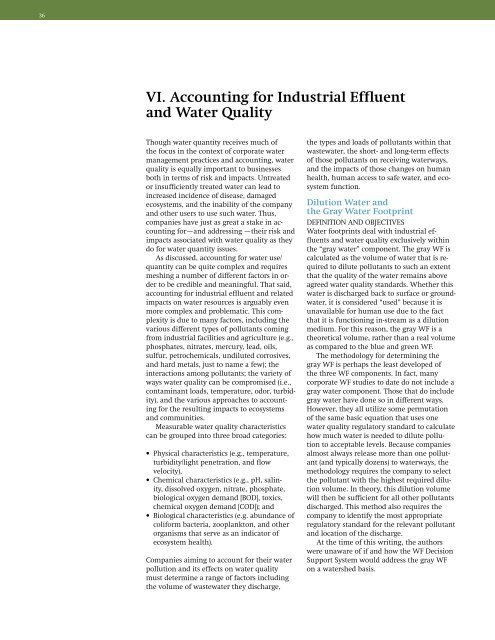Corporate Water Accounting: An Analysis of Methods and Tools for ...
Corporate Water Accounting: An Analysis of Methods and Tools for ...
Corporate Water Accounting: An Analysis of Methods and Tools for ...
You also want an ePaper? Increase the reach of your titles
YUMPU automatically turns print PDFs into web optimized ePapers that Google loves.
36<br />
VI. <strong>Accounting</strong> <strong>for</strong> Industrial Effluent<br />
<strong>and</strong> <strong>Water</strong> Quality<br />
Though water quantity receives much <strong>of</strong><br />
the focus in the context <strong>of</strong> corporate water<br />
management practices <strong>and</strong> accounting, water<br />
quality is equally important to businesses<br />
both in terms <strong>of</strong> risk <strong>and</strong> impacts. Untreated<br />
or insufficiently treated water can lead to<br />
increased incidence <strong>of</strong> disease, damaged<br />
ecosystems, <strong>and</strong> the inability <strong>of</strong> the company<br />
<strong>and</strong> other users to use such water. Thus,<br />
companies have just as great a stake in accounting<br />
<strong>for</strong>—<strong>and</strong> addressing —their risk <strong>and</strong><br />
impacts associated with water quality as they<br />
do <strong>for</strong> water quantity issues.<br />
As discussed, accounting <strong>for</strong> water use/<br />
quantity can be quite complex <strong>and</strong> requires<br />
meshing a number <strong>of</strong> different factors in order<br />
to be credible <strong>and</strong> meaningful. That said,<br />
accounting <strong>for</strong> industrial effluent <strong>and</strong> related<br />
impacts on water resources is arguably even<br />
more complex <strong>and</strong> problematic. This complexity<br />
is due to many factors, including the<br />
various different types <strong>of</strong> pollutants coming<br />
from industrial facilities <strong>and</strong> agriculture (e.g.,<br />
phosphates, nitrates, mercury, lead, oils,<br />
sulfur, petrochemicals, undiluted corrosives,<br />
<strong>and</strong> hard metals, just to name a few); the<br />
interactions among pollutants; the variety <strong>of</strong><br />
ways water quality can be compromised (i.e.,<br />
contaminant loads, temperature, odor, turbidity),<br />
<strong>and</strong> the various approaches to accounting<br />
<strong>for</strong> the resulting impacts to ecosystems<br />
<strong>and</strong> communities.<br />
Measurable water quality characteristics<br />
can be grouped into three broad categories:<br />
• Physical characteristics (e.g., temperature,<br />
turbidity/light penetration, <strong>and</strong> flow<br />
velocity),<br />
• Chemical characteristics (e.g., pH, salinity,<br />
dissolved oxygen, nitrate, phosphate,<br />
biological oxygen dem<strong>and</strong> [BOD], toxics,<br />
chemical oxygen dem<strong>and</strong> [COD]); <strong>and</strong><br />
• Biological characteristics (e.g. abundance <strong>of</strong><br />
coli<strong>for</strong>m bacteria, zooplankton, <strong>and</strong> other<br />
organisms that serve as an indicator <strong>of</strong><br />
ecosystem health).<br />
Companies aiming to account <strong>for</strong> their water<br />
pollution <strong>and</strong> its effects on water quality<br />
must determine a range <strong>of</strong> factors including<br />
the volume <strong>of</strong> wastewater they discharge,<br />
the types <strong>and</strong> loads <strong>of</strong> pollutants within that<br />
wastewater, the short- <strong>and</strong> long-term effects<br />
<strong>of</strong> those pollutants on receiving waterways,<br />
<strong>and</strong> the impacts <strong>of</strong> those changes on human<br />
health, human access to safe water, <strong>and</strong> ecosystem<br />
function.<br />
Dilution <strong>Water</strong> <strong>and</strong><br />
the Gray <strong>Water</strong> Footprint<br />
Definition <strong>and</strong> Objectives<br />
<strong>Water</strong> footprints deal with industrial effluents<br />
<strong>and</strong> water quality exclusively within<br />
the “gray water” component. The gray WF is<br />
calculated as the volume <strong>of</strong> water that is required<br />
to dilute pollutants to such an extent<br />
that the quality <strong>of</strong> the water remains above<br />
agreed water quality st<strong>and</strong>ards. Whether this<br />
water is discharged back to surface or groundwater,<br />
it is considered “used” because it is<br />
unavailable <strong>for</strong> human use due to the fact<br />
that it is functioning in-stream as a dilution<br />
medium. For this reason, the gray WF is a<br />
theoretical volume, rather than a real volume<br />
as compared to the blue <strong>and</strong> green WF.<br />
The methodology <strong>for</strong> determining the<br />
gray WF is perhaps the least developed <strong>of</strong><br />
the three WF components. In fact, many<br />
corporate WF studies to date do not include a<br />
gray water component. Those that do include<br />
gray water have done so in different ways.<br />
However, they all utilize some permutation<br />
<strong>of</strong> the same basic equation that uses one<br />
water quality regulatory st<strong>and</strong>ard to calculate<br />
how much water is needed to dilute pollution<br />
to acceptable levels. Because companies<br />
almost always release more than one pollutant<br />
(<strong>and</strong> typically dozens) to waterways, the<br />
methodology requires the company to select<br />
the pollutant with the highest required dilution<br />
volume. In theory, this dilution volume<br />
will then be sufficient <strong>for</strong> all other pollutants<br />
discharged. This method also requires the<br />
company to identify the most appropriate<br />
regulatory st<strong>and</strong>ard <strong>for</strong> the relevant pollutant<br />
<strong>and</strong> location <strong>of</strong> the discharge.<br />
At the time <strong>of</strong> this writing, the authors<br />
were unaware <strong>of</strong> if <strong>and</strong> how the WF Decision<br />
Support System would address the gray WF<br />
on a watershed basis.
















